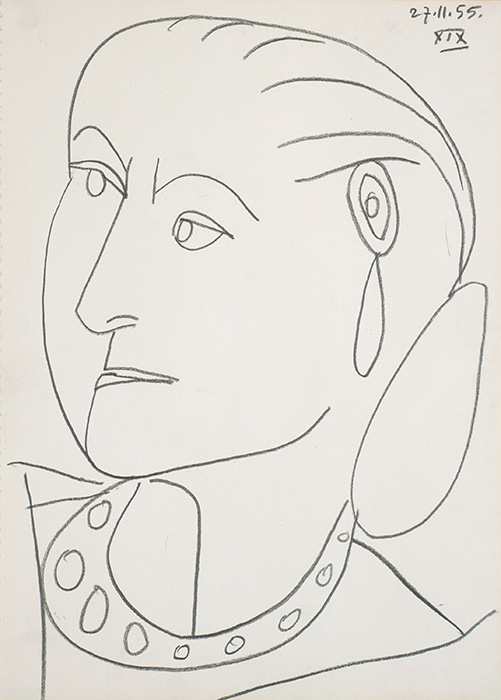
Helena Rubinstein: Beauty Is Power

Pablo Picasso, Portrait of Helena Rubinstein XIX 27-11-1955, 1955.
Conté crayon on paper, 17 1/4 x 12 5/8 in. (43.8 x 32.1 cm). Himeji City Museum of Art, Japan. © 2014 Estate of Pablo Picasso / Artists Rights Society (ARS), New York.
You knew Helena Rubinstein. That is, even if you didn’t actually know her, you know her type: the smart, feisty, implacably-willed Jewish woman who just goes ahead and does what she wants, no matter what the world tells her. Like others of her ilk—Estée Lauder, Georgette Klinger, Beatrice Alexander and Ruth Handler—she made her name in an arena—cosmetics—where being a woman was an advantage, not a liability. The newly opened show at the Jewish Museum, interdisciplinary in nature, offers a fascinating glimpse into the life the Jewish girl with humble roots in Poland who grew up to become, “a global icon of female entrepreneurship and a leader in art, design, fashion and philanthropy.”
Born in 1872, Rubinstein fled an arranged marriage in 1888. By 1896, she had gone from Krakow to Vienna and then to Australia, where she established her first business. She flat-out rejected the notion that only prostitutes and women of questionable virtue wore make up, and instead built an empire on the premise that wearing make-up was a self-assertive, empowering act, one that allowed a woman to literally create the face that she showed to the world. The title of the show is a tag line from one of Rubinstein’s own advertising campaigns, and the exhibition’s wide-ranging offerings—primarily artwork, but also clothing, jewelry, packaging and advertising, and miniature rooms—demonstrate the many ways that statement can be interpreted.
As a collector, Rubinstein was both canny and idiosyncratic in her taste; her acquisitions include works by Pablo Picasso, Elie Nadleman, Frida Kahlo, Max Ernst, Leonor Fini, Joan Miró, and Henri Matisse and when she was alive, they graced the homes she kept in London, Paris, New York, the South of France and Greenwich, CT. Also represented are 30 pieces from her visionary collection of African and Oceanic art, a collection that ultimately helped to reshape the way this work was viewed—and valued—in the west.



